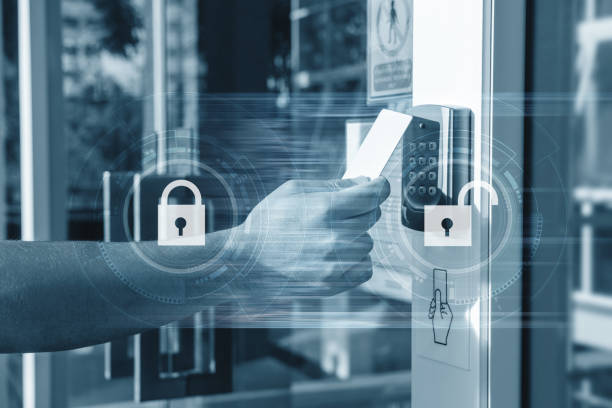In the sphere of security, the importance of robust systems cannot be emphasised enough. As businesses and organisations strive to safeguard their assets and personnel, the spotlight often falls on one integral component of security infrastructure: access control systems. Access control has undergone tremendous evolution, especially with the rise of digital technologies, offering unprecedented capabilities in security management and oversight.
The Evolution of Access Control
Gone are the days when a simple lock and key were the primary means of securing an entry point. Modern access control systems represent the pinnacle of security technology, blending convenience with comprehensive protection strategies. Today’s systems are adept at not only permitting or denying entry but also recording data, monitoring access and providing multiple layers of security that were once the stuff of science fiction.
Benefits of Modern Access Controls
The advantages of deploying contemporary access control solutions are manifold. Firstly, they offer a level of customisation that allows security systems to be tailored to the exact needs of an establishment. Secondly, they offer scalability, meaning businesses can expand their security systems as they grow, ensuring that safety measures keep pace with company development. Lastly, modern systems provide added functionalities such as biometric scans and remote access, enhancing the user experience while bolstering security measures.
Seamless Integration
One of the remarkable features of contemporary access control arrangements is their ability to be seamlessly integrated into existing security infrastructure. This means that businesses can upgrade their systems without the need for an entire overhaul, saving costs and minimising disruptions to daily operations. Such integration capabilities also allow for central management of security, crucial for large organisations with multiple points of entry.
Customisable Access Levels
Moreover, modern systems enable the setting of varying access levels, ensuring that personnel are granted entry only to areas necessary for their role. This targeted access not only enhances security by reducing potential vulnerabilities but also helps in maintaining organisational confidentiality.
Real-Time Monitoring and Alerts
With real-time monitoring, security personnel can keep a vigilant eye on all areas under surveillance. This feature is made more robust through instant alerts that are triggered by any unauthorised attempt at entry, enabling swift response to potential breaches. It’s this kind of immediate action that can make all the difference in preventing security incidents.
Reduced Risk of Duplication
A significant advantage of digital access systems is the reduced risk of key duplication that plagues traditional lock and key mechanisms. Since many modern systems utilize complex digital codes or biometric recognition, the risk of unauthorised duplication or hacking is considerably lowered, offering peace of mind for security managers.
Data Collection and Analysis
The data collected by modern access control systems isn’t limited to entry and exit monitoring. These systems can provide analytics that help in understanding traffic patterns, peak access times, and even assist in emergency planning. This data-driven approach allows for informed decision-making when it comes to bolstering security protocols or optimising operations.
Cost-Effectiveness Over Time
One cannot overlook the cost-effectiveness of these systems over the long term. By minimising the potential for security breaches, such systems protect against losses and liability. In addition, because many modern systems require less physical hardware and can be updated through software, they also tend to be cheaper to maintain and upgrade.
Integration with Other Security Measures
Access control systems don’t work in isolation; they are often part of a larger security ecosystem that may include video surveillance, alarms, and cybersecurity measures. The ability of access control solutions to interface with other security systems enhances situational awareness and leads to a comprehensive security strategy that addresses multiple vectors of threat.
Compliance with Regulatory Standards
Another advantage of modern access control systems is their ability to ensure compliance with regulatory standards. Organisations often have to abide by specific laws and regulations when it comes to security, and access systems can be configured to meet these stringent requirements, thereby avoiding potential legal complications.
Flexible Access Solutions for Various Environments
From corporate offices to industrial warehouses, the versatility of modern access control systems allows them to be effective in a wide range of environments. This flexibility ensures that no matter the sector, be it healthcare, finance, or education, there is a security solution that can be customised to the unique needs of the establishment.
Enhanced User Experience
It’s important to note that modern access systems not only enhance security but also improve the user experience. Gone are the cumbersome processes of traditional security checks; today’s systems allow for swift, hassle-free access that does not compromise on safety, thus ensuring a seamless experience for authorised individuals.
Forward-Thinking Security with Smart Technologies
At the cutting-edge of these systems are smart technologies like artificial intelligence and machine learning, which allow access controls to adapt to new threats and learn from access patterns to improve security measures continually. By incorporating such forward-thinking technologies, organisations place themselves ahead of the curve in security management.
The Future of Access Control
The trajectory of access control technology is firmly towards greater integration, intelligence, and adaptability. With each passing year, these systems become more refined, offering not just robust security solutions but also valuable insights into the functioning of organisations. In the mission to enhance safety, modern access control systems stand as both guardians and guides, ushering in a new era of security intelligence.
As the security landscape evolves, so do the requirements for protecting critical infrastructures, data, and personnel. With the advanced capabilities of modern access control systems, businesses and organisations can step forward with confidence, knowing that they are equipped to face the challenges of a complex world, where safety and efficiency are paramount.



